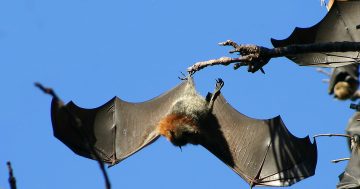
The challenges around the flying-fox camp at Batemans Bay continue to deepen with Eurobodalla Shire Council accepting the problem has grown too big and residents increasingly distressed.
Calls for a dispersal program to break up the camp and move the protected species on have reached State and Federal Parliament with the Environment Minister at both levels consulted.
The scientist and planner behind the Eurobodalla’s current course of action has warned of legal risks around such a plan, despite dispersal success at a Sydney site she was responsible for.
Beth Medway from Eco Logical Australia helped develop the flying-fox management plan for Eurobodalla Shire Council and Sutherland Shire Council.
Ms Medway says any formal agreement around dispersal of the Grey-headed Flying-fox with the NSW Office of Environment would involve Council agreeing to accept liability.
“If the bats move to another place and cause a problem, whoever undertook the original dispersal would have to address the dispersal in the other locations, that’s part of the typical conditions,” Ms Medway says.
Given the nature of flying-foxes movements, proving the origins of a camp can be difficult, but none the less Ms Medway suggests liability needs to be a factor in considering a dispersal program.
Click play to learn more – [sc_embed_player fileurl=”http://aboutregional.com.au/wp-content/uploads/sites/2/2016/04/Beth-Medway-1.mp3″]
It’s another dynamic in this fractured and complicated stand off between the natural and human environments.
Dispersal worked in Sutherland…
To date the strategy from Eurobodalla Shire Council has centered around actively managing vegetation at the camp which is based at the Batemans Bay Water Gardens.
Since 2015 a buffer between the camp and surrounding homes has been created and the flying-foxes favourite palm trees have been removed but the camp has continued to grow. The number of animals is estimated to be around 100,000, which accounts for 20% of the national population.
The increasing anxiety and pressures human residents have been feeling are significant. Locals talk about feeling sick with the smell, contaminated tank water, property stained and damaged by droppings and sleep interrupted by screeching.
Eurobodalla Mayor Lindsay Brown told Radio 2EC this week that residents are at the end of their tether.
More dramatic action is now being called for along the lines adopted by Sutherland Shire Council where a dispersal program began in August last year at the Kareela Camp.
Mayor Brown says dispersal was investigated for the Water Gardens before now with the cost at the time put at between $500,000 and one million dollars.
“Today we have four or five times as many flying foxes in Batemans Bay,” Cr Brown says.
The Shire’s State MP Andrew Constance has suggested the Baird Government would help cover the cost as they did in Sutherland Shire.
Beth Medway warns against comparing the Water Gardens and Kareela Camps.
“Overall the numbers of flying foxes at that (Kareela) site have dramatically reduced,” Ms Medway says.
However she says the geography and situation is very different to the Water Gardens.
“Kareela is a very small area of bush land in a gully, compared to the Water Gardens which is much, much bigger with a big body of water in the middle,” she says.
“It is doable (at the Water Gardens) but the resourcing involved would be significant,”
“At Kareela we had 10 Council and consulting staff involved in the dispersal on any one day,”
Ms Medway suggests the number of people needed for a similar course of action at Batemans Bay potentially makes it not viable.
Click play to learn more – [sc_embed_player fileurl=”http://aboutregional.com.au/wp-content/uploads/sites/2/2016/04/Beth-Medway-2.mp3″]
Given what is trying to be achieved, dispersal methods are disruptive – equally so to residents within 150 to 300 meters of the camp. At Kareela loud music, smoke and bright flashing lights were all used in a pre-dawn effort.
“Occasionally they do came back and there is further dispersal action that is needed,” Ms Medway says.
Nine months on and $250,000 later Council staff are still involved at Kareela four to seven days a week monitoring the site, which a Sutherland Shire spokesperson says will be the case for the next 3 years at least.
“It’s not a case of just anybody going along and flashing lights,” Ms Medway explains.
The guidelines from the NSW Office of Environment point to the need for a dispersal team that consists of trained, inducted and vaccinated personnel, along with the presence of a qualified flying fox expert and licensed wildlife carer.
Odds are dispersal won’t work…
The success at Kareela stands in contrast to the current scientific advice and the experience other communities have had with dispersal.
Based on research quoted by Eurobodalla Shire Council, in 16 of the 17 dispersals studied flying-foxes stayed in the local area, normally moving only 600 metres from the original camp.
“We just never know where the flying-foxes could end up,” Ms Medway says.
“There have been cases where dispersals have caused a bigger problem than where they (flying-foxes) were originally located,”
“When we did the consultation for the Water Gardens, a lot of people from the community were very concerned about the potential of moving the camp into an even less desirable location, where more people would be impacted,” she says.
A spokesperson for Eurobodalla Shire says 10 sites have been identified in the Batemans Bay urban area where the flying-foxes could relocate to following dispersal.
In this challenging and difficult situation the humans living in the midst of the Water Gardens Camp have often felt that concern for the endangered Grey-headed Flying-fox seems to be greater than the concern expressed for them and their situation.
Ms Medway says she feels for residents around the Water Gardens and is confident that with time the flying-foxes will move away and locals will have relief.
“In Sydney at the moment camps are empty and it’s not about dispersals, it’s because food is not available,” she says.
Click play to learn more – [sc_embed_player fileurl=”http://aboutregional.com.au/wp-content/uploads/sites/2/2016/04/Beth-Medway-HOPE-mp3_01.mp3″]
Until the flying-foxes move on Ms Medway encourages residents to make the most of the relief options Council has available, including clothes line and car covers and access to high pressure water cleaners.
Why the Water Gardens?…
Flowering spotted gums and fruiting rain forest species along the South Coast are thought to be the main drivers behind the Water Gardens Camp.
The water in the gardens itself is another plus for flying-foxes who struggle on days of high temperatures. The cooler environment is key for the species survival, with the potential for mass deaths on days where the temperature hits the high thirties.
Speaking on ABC South East this week the author of the Australian Government’s 2009 National Recovery Plan for the Grey- headed Flying-fox, suggested that the problem in Batemans Bay and in a number of communities around Australia is one that has come home to roost.
Ecologist Dr Peggy Eby pointed to the wide spread clearing of flying-fox habitat as being central to this problem, with the animals forced into marginal areas like the Water Gardens to survive.
In terms of a resolution Dr Eby believes dispersal is a high risk strategy.
“The reality is it’s much easier to adapt the behaviour of humans than the behaviour of wildlife,” she told the ABC.
The next step…
Eurobodalla Shire Council has called a community meeting on the issue and is inviting mayors from other affected communities around the country. That meeting will happen on May 16 between 5pm and 7pm at the Batemans Bay Soldiers Club.
An opportunity perhaps for the Batemans Bay community and Eurobodalla Shire Council to drive solutions and ideas that move this forward for people and flying-foxes.











